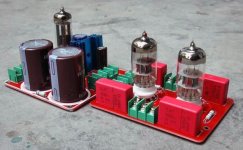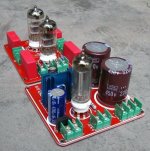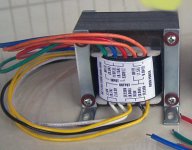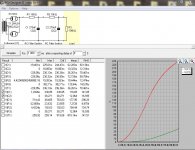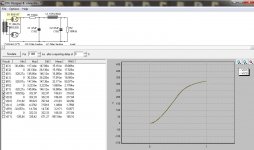After listening to my Yaqin MC-100B for couple of months it was clear that "tube" sound was what I've been looking for in my whole life 
Even though today it's pretty much modified to another level with new coupling caps, PSU caps, Kiwame resistors and so one I've long time been looking for a suitable preamp (and ofcourse wanna try tubes here too)
I saw this very cheap and simple "SRPP" pre and i got it for a very nice price together with transformer and case including Alps RK27 100K. All this is on it's way as we speak. It's two boards (one for psu) Tubes are two 6N3 (gonna be replaced to russian or american) and one chinese 6z4 as rectifier.
Anyway, I bought it as a kit because I feel I can do it and learn something along the way... like I almost did with my MC100.
I've been searching around a lot and saw that many people thinks this SRPP is a poor design. Seen many different versions out there and this appear to be the newest so fare.
I know there is a lot of skilled people out there (or here that maybe can look at this scheamtic and say if there is something that is totally wrong.
that maybe can look at this scheamtic and say if there is something that is totally wrong.
Personally (and what I've been reading) it seems that the capacitance are way to high (220uf/450Vx2) for this small rectifier tube. planning to change to a american made 6x4 even if i have to re-route layout.
Also coupling caps seems to vary alot with different batch (or whats the cheapest parts available), 0,47uf on input seems to be the same all time but output varies from 1,0uf up to 2,2uf and also caps before and after LM7806 goes from 4700uf up to 8200uf and from 470uf up to 2200uf on the last..
What would be a OK value?
I have a big stock of hq caps like BC, panasonic, nichicon and elnas and also a bunch of many good resistors laying around so mod/tweaking is easily done.
Not sure either if to put the pot before or after the "pre", reading mixed answers, like before is better because bla bla.....
As you probably see I'm pretty newbie and here to learn and hope that maybe somebody else with this design can get some help too.
The source is a AK4399/is2/xmos dac (from ebay also) and preamp right now is a Yamaha RX-V2010. (A/V processor/amp)
Thanks for your time,
Even though today it's pretty much modified to another level with new coupling caps, PSU caps, Kiwame resistors and so one I've long time been looking for a suitable preamp (and ofcourse wanna try tubes here too)
I saw this very cheap and simple "SRPP" pre and i got it for a very nice price together with transformer and case including Alps RK27 100K. All this is on it's way as we speak. It's two boards (one for psu) Tubes are two 6N3 (gonna be replaced to russian or american) and one chinese 6z4 as rectifier.
Anyway, I bought it as a kit because I feel I can do it and learn something along the way... like I almost did with my MC100.
I've been searching around a lot and saw that many people thinks this SRPP is a poor design. Seen many different versions out there and this appear to be the newest so fare.
I know there is a lot of skilled people out there (or here
Personally (and what I've been reading) it seems that the capacitance are way to high (220uf/450Vx2) for this small rectifier tube. planning to change to a american made 6x4 even if i have to re-route layout.
Also coupling caps seems to vary alot with different batch (or whats the cheapest parts available), 0,47uf on input seems to be the same all time but output varies from 1,0uf up to 2,2uf and also caps before and after LM7806 goes from 4700uf up to 8200uf and from 470uf up to 2200uf on the last..
What would be a OK value?
I have a big stock of hq caps like BC, panasonic, nichicon and elnas and also a bunch of many good resistors laying around so mod/tweaking is easily done.
Not sure either if to put the pot before or after the "pre", reading mixed answers, like before is better because bla bla.....
As you probably see I'm pretty newbie and here to learn and hope that maybe somebody else with this design can get some help too.
The source is a AK4399/is2/xmos dac (from ebay also) and preamp right now is a Yamaha RX-V2010. (A/V processor/amp)
Thanks for your time,
Attachments
Last edited:
The gain of this pre SRPP is about 22...23 dB, so it amplifies the input signal about 14 times.
This is more of a problem than an advantage. Usually quite little (6...10 dB) or no gain is required if typical signal sources - like CD players - are used.
I would use instead a voltage amplifying stage with some local negative feedback to adjust the gain at proper level and then a cathode follower as an output stage.
The volume potentiometer should be at the input or between the stages.
Something like this:
This is more of a problem than an advantage. Usually quite little (6...10 dB) or no gain is required if typical signal sources - like CD players - are used.
I would use instead a voltage amplifying stage with some local negative feedback to adjust the gain at proper level and then a cathode follower as an output stage.
The volume potentiometer should be at the input or between the stages.
Something like this:
An externally hosted image should be here but it was not working when we last tested it.
Last edited:
Almost all modern systems need no line stage. Two exceptions:
1. people who actually need a buffer to drive long cables and/or a low and non-linear power amp input impedance.
2. people who actually want a mild FX box to add a little noise and distortion.
In either case the gain of most line stages is far too high.
In the case of the SRPP it will have a gain around mu/2 - far too much for most cases. It will have an output impedance of about Ra/3 - far too high for a good buffer and probably even higher than the original source!
The input coupling cap sets the input LF rolloff, when combined with the grid resistor. There is some merit in making this cap as small as possible (but no smaller!) so it becomes the dominant LF rolloff.
Modern (mis-)practice seems to be to use reservoir caps which are bigger than necessary and bigger than the rectifier can cope with. I guess people think that if X amount of cap is good then 5X must be better. Beyond a certain point the amount of hum is set by grounding details rather than cap value.
1. people who actually need a buffer to drive long cables and/or a low and non-linear power amp input impedance.
2. people who actually want a mild FX box to add a little noise and distortion.
In either case the gain of most line stages is far too high.
In the case of the SRPP it will have a gain around mu/2 - far too much for most cases. It will have an output impedance of about Ra/3 - far too high for a good buffer and probably even higher than the original source!
The input coupling cap sets the input LF rolloff, when combined with the grid resistor. There is some merit in making this cap as small as possible (but no smaller!) so it becomes the dominant LF rolloff.
Modern (mis-)practice seems to be to use reservoir caps which are bigger than necessary and bigger than the rectifier can cope with. I guess people think that if X amount of cap is good then 5X must be better. Beyond a certain point the amount of hum is set by grounding details rather than cap value.
Thx for answers. I read a review about my preamp now (yamaha adventage 2010) that it has a gain of around 13-14 db and puts out 3-4 volts on the pre section. I think it's sounds good compared to an old Sony ES receiver but I tried my Yaqin once without any pre (now it's mod to be an amp only) and heard a big step up in SQ... So ofcourse since then began to think about a new pre. The real reason for a pre is thar my Yaqin only drives my mid/tw and i have a Behringer Inuke 3000 with a DCX2496 for everything under 180hz. Also would like to add that I've many times tried to drive a amp (SS) direct from a cd with volume and also tried a passive pre but i don't like "that" sound. Sounds clean and clear but missing the drive and dynamics to much so my assumption is that my ears need a "nice" pre. The SRPP cought my attention cuz it looks simple (for me) but ofcourse I also saw that maybe the gain is HIGH, to high.
I would like of course build something from "scratch" of some proven schematic (above for example) but i think I'll need even more experience /or a very detailed schematic. In the beginning i was looking also at that "akaido" and the "grounded grid" pre but i guess the cheapness got to me
I ordered this beacause it's was almost ready to "go". I mean not to hard to do wrong with wiring and so cuz of the printed pcb.
Anyway of course i can throw it away if it's worthless. But i think i will try it atleast. I heard some people saying it actually sounded pretty ok for what it was.
Can I do something with the transformer I ordered if i don't use this srpp circiut. It seems to of good quality compared to others i've seen on ebay. Primaryside: 230-0-230V (0.04A) and 2x6.3V (1,7A/0.7A)
Is there any other tubes with lower MU that can be used or do you know of any other schematic that is foolproof for amateurs that fits my transf? I can't really tell if above schematic suits?
that fits my transf? I can't really tell if above schematic suits?
I would like of course build something from "scratch" of some proven schematic (above for example) but i think I'll need even more experience /or a very detailed schematic. In the beginning i was looking also at that "akaido" and the "grounded grid" pre but i guess the cheapness got to me
I ordered this beacause it's was almost ready to "go". I mean not to hard to do wrong with wiring and so cuz of the printed pcb.
Anyway of course i can throw it away if it's worthless. But i think i will try it atleast. I heard some people saying it actually sounded pretty ok for what it was.
Can I do something with the transformer I ordered if i don't use this srpp circiut. It seems to of good quality compared to others i've seen on ebay. Primaryside: 230-0-230V (0.04A) and 2x6.3V (1,7A/0.7A)
Is there any other tubes with lower MU that can be used or do you know of any other schematic that is foolproof for amateurs
Last edited:
The input coupling cap sets the input LF rolloff, when combined with the grid resistor. There is some merit in making this cap as small as possible (but no smaller!) so it becomes the dominant LF rolloff.
Modern (mis-)practice seems to be to use reservoir caps which are bigger than necessary and bigger than the rectifier can cope with. I guess people think that if X amount of cap is good then 5X must be better. Beyond a certain point the amount of hum is set by grounding details rather than cap value.
If I try this preamp/srpp i was thinking 1,5uF output (have 2 nice audyn cap plus laying around) and then keep the red wima mkp10 0,47uf that comes with it. For supply caps 2x2200uf before 7806 reg and a single 1000uf after. In the other something like 50+50uf after tube rectifier.
You were talking about ground details. In my Yaqin Kt88, all grounds going to the same point. Caps, negative bias and signal. Ok to do here to? I don't have any problem with groundloops and it's very "noise-free". That's how it's done from the factory btw. Read somewhere that signal/chassie earth should not be together but it's seems to work fine here atleast.
I wonder if i have to adjust the resistors (100R x2)if i lower capacitance to 2x47uf from schematics 220x2?
And if i want to try a 10H chocke, should it be between the caps? And what about resistors here?
If i like this kit I have opportunity to change the rectifier to a 6x5gt. Any concerns? Many nos tubes to get hold of
And if i want to try a 10H chocke, should it be between the caps? And what about resistors here?
If i like this kit I have opportunity to change the rectifier to a 6x5gt. Any concerns? Many nos tubes to get hold of
Make sure to double check any caps that came with the kit.
For coupling caps I like Russian pio, auricaps, and Jensen silver z for low-mid price range.
Use PSU designer from Duncan amps for some PSU modeling. But a c-l-c or c-r-c are common arrangements. A 5-10 h choke could work nicely.
As for resistors it sure can't hurt to use higher end in the signal path and cathodes. I like vishay metal film and kiwame
For coupling caps I like Russian pio, auricaps, and Jensen silver z for low-mid price range.
Use PSU designer from Duncan amps for some PSU modeling. But a c-l-c or c-r-c are common arrangements. A 5-10 h choke could work nicely.
As for resistors it sure can't hurt to use higher end in the signal path and cathodes. I like vishay metal film and kiwame
A stock of kiwames here already my favourite.
my favourite.
I have some mundorf sio and audyn cap Plus here i will try. The supplied wima mkp10 and mks4 are not my cup of tea
Thx for psu designer. Didn't know it existed downloaded, will try later.
downloaded, will try later.
The other caps for filament regulation i will replace right away with some BC and panasonic fm that i bought "locally". Have experienced many "fakes" from ebay..
I have some mundorf sio and audyn cap Plus here i will try. The supplied wima mkp10 and mks4 are not my cup of tea
Thx for psu designer. Didn't know it existed
The other caps for filament regulation i will replace right away with some BC and panasonic fm that i bought "locally". Have experienced many "fakes" from ebay..
Yesterday my kit arrived and today i soldered everything. But they forgot to send me the pot (alps rk27)
But it was actually ok cuz i started to doubt what value to choose from.. 20,50,250 or 100k that could fit with my SS dac (ak4399) - I don't know the impedance. So if someone know, please tell me. I know ss usually are 10k and tubes are 100k.
Just so i could listen i took the old one from my yaqin (20K) and it works fine although would be nice to have total silence when knob is turned down all the way. Is a 50k pot gonna make it more "silent" with volume turned down??
The sound is very open and dynamic. Alot of 3D. It seems like it's favour music like mark knopler /allan taylor infront of for example metallica even though sound is dynamic. It needs more burn in i think. Voices sounds truthfull/real. Sometimes i have a feeling some pinpoint/perspective is missing. Lite muffled maybe.
I'm atleast happy its working
Other info: tubes were NOS made 1982.
Some warning:
This kit from Ebay came with 13 yr old caps (270uf!!!!!!!) and one was bulging...
Filament caps was a sunnycon (hahaha) 4700uf, also in bad shape but working... Resistors were magnetic carbon/metal mixed and schematic have been updated. There is 5 new resistors more than shown above in schematic. I will write it down tomorrow maybe so you all can see and comment.
But it was actually ok cuz i started to doubt what value to choose from.. 20,50,250 or 100k that could fit with my SS dac (ak4399) - I don't know the impedance. So if someone know, please tell me. I know ss usually are 10k and tubes are 100k.
Just so i could listen i took the old one from my yaqin (20K) and it works fine although would be nice to have total silence when knob is turned down all the way. Is a 50k pot gonna make it more "silent" with volume turned down??
The sound is very open and dynamic. Alot of 3D. It seems like it's favour music like mark knopler /allan taylor infront of for example metallica even though sound is dynamic. It needs more burn in i think. Voices sounds truthfull/real. Sometimes i have a feeling some pinpoint/perspective is missing. Lite muffled maybe.
I'm atleast happy its working
Other info: tubes were NOS made 1982.
Some warning:
This kit from Ebay came with 13 yr old caps (270uf!!!!!!!) and one was bulging...
Filament caps was a sunnycon (hahaha) 4700uf, also in bad shape but working... Resistors were magnetic carbon/metal mixed and schematic have been updated. There is 5 new resistors more than shown above in schematic. I will write it down tomorrow maybe so you all can see and comment.
Last edited:
Hi,
One word of warning for the more technically inclined:
SRPP: SHUNT REGULATED PUSH-PULL is a monstruous mis-nomer.
To be kind, at best it's a circuit that can be of use for driving a lowish impedance source of say 10K or less (preferably less) fixed input impedance whilst sill pertaining some gain (mu/2) but not much else.
The worst part however is its extremely poor PSRR.
IOW, lest you understand the circuit and have a particular use for, avoid it. It's a bit akin to a hoax really....
Ciao,
One word of warning for the more technically inclined:
SRPP: SHUNT REGULATED PUSH-PULL is a monstruous mis-nomer.
To be kind, at best it's a circuit that can be of use for driving a lowish impedance source of say 10K or less (preferably less) fixed input impedance whilst sill pertaining some gain (mu/2) but not much else.
The worst part however is its extremely poor PSRR.
IOW, lest you understand the circuit and have a particular use for, avoid it. It's a bit akin to a hoax really....
Ciao,
In balanced form, yes. Most people run it unbalanced, with the lower cathode bypassed, and then the PSRR should be OK.fdegrove said:The worst part however is its extremely poor PSRR.
Yes i understand that its not the best circuit around but to my ears it sounds not to bad. For those people here who know so much. What would you improve? This is my first pre amp diy.. But it's so fun  and cheap
and cheap
I was testing voltage and i have only 4,27v dc filament and 230v dc to plate. If now transformer should give 230v /6.3vac on secondary shouldn't it be higher after rectifier like 280?? I've been reading up on 7806 and see that i can not get 6,3v with this transformer, right? Is it better with a 1085?
Thinking to try with ac filament too. If i dont get hum maybe i'll go that way.
More costly is just to buy a 9v trafo only for filament. Should work better with L7806.
The 6n3 gets only fingerwarm actually as it is.. I know it's not good for tube with undervoltage but i have new russians on the way.
I was testing voltage and i have only 4,27v dc filament and 230v dc to plate. If now transformer should give 230v /6.3vac on secondary shouldn't it be higher after rectifier like 280?? I've been reading up on 7806 and see that i can not get 6,3v with this transformer, right? Is it better with a 1085?
Thinking to try with ac filament too. If i dont get hum maybe i'll go that way.
More costly is just to buy a 9v trafo only for filament. Should work better with L7806.
The 6n3 gets only fingerwarm actually as it is.. I know it's not good for tube with undervoltage but i have new russians on the way.
I have not had time to update the schematic but they have implented (for one channel ) 1x 10k to earth after first cap 0,47 instead of the 100k and 1x 10k to earth before last cap 1,0uf .
In psu the first 100R is there but second (between caps) are 10k and then a bleeder over last cap of 100k.
In psu the first 100R is there but second (between caps) are 10k and then a bleeder over last cap of 100k.
In balanced form, yes. Most people run it unbalanced, with the lower cathode bypassed, and then the PSRR should be OK.
Can you please explain more detailed? What Can i do to improve it to be an ok SRPP? Components i have alot of. I saw in datasheet that they use 240R instead of here 470R (for biasing?) Somebody wrote that a srpp goes in class A just beacause it's an SRPP. Also other tube pre amps i've seen the rather use 1M to bleed of maybe gain (?) after and before cap? thats what its for right?
I've been doing some modelling with Duncans psu designer and and pretty hard to say what's the best (maybe i'm to slow
Over 800 people checked this thread. I'm surprised not more people have commented.
I've tried to feed tubes with AC but got hum that i hear easy from listeing position. I will try to re-route the 6,3v line and feed directly instead of going through the pcb with a better twisted cable according to tip here on diyaudio forum and see if it helps. I couldn't hear any difference in SQ that someone mention in other threads.
But what really made a difference was to replace those old Nippon chemicon serie "CE" to BC 056/47uf para. with 2x10uf arcotronics MKPs. Holy mother! Smooth as silk with extreme big soundstage.
I've tried to feed tubes with AC but got hum that i hear easy from listeing position. I will try to re-route the 6,3v line and feed directly instead of going through the pcb with a better twisted cable according to tip here on diyaudio forum and see if it helps. I couldn't hear any difference in SQ that someone mention in other threads.
But what really made a difference was to replace those old Nippon chemicon serie "CE" to BC 056/47uf para. with 2x10uf arcotronics MKPs. Holy mother! Smooth as silk with extreme big soundstage.
Difficult to comment on a moving target. Show us your current circuit.Max Martin said:Over 800 people checked this thread. I'm surprised not more people have commented.
As I said, the SRPP has too much gain. The unbalanced SRPP (with better PSRR) has even more gain. You can't improve the wrong circuit; you have to change the circuit.Can you please explain more detailed? What Can i do to improve it to be an ok SRPP?
Is the heater voltage referenced to B+/4?
I'm not sure what you mean here.
I measured by the input of the board (near tubes) after regulator and caps. Checked again; 4,47 V here. B+ is now with new caps 225V. (before 230V) after rectifier and caps.
I've been going AC on the tubes and get about 6.3 V now and tubes little bit hotter. Little hum though... Used a screened cable and soldered directly and hum is there but much lower but I can't t live with it i think. Little bit annoying.
Also Russian tubes arrived today. 2x 6n3p-EB and one 6X4-R. From first note there was a big difference. All kinds of instruments sounds much more "true" and everything is so clear. Really impressed just after couple of hours compared to the chinese.
- Status
- This old topic is closed. If you want to reopen this topic, contact a moderator using the "Report Post" button.
- Home
- Amplifiers
- Tubes / Valves
- My first preamp with tubes
